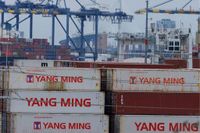China's exports saw a surprising boost in April 2025, growing by 8.1%, despite a significant decline in shipments to the United States. According to a report by Bloomberg, exports to the U.S. plummeted by 21% as a direct consequence of heightened tariffs imposed during Donald Trump's presidency. This shift indicates a strategic pivot by China towards other markets, particularly in Southeast Asia, where exports surged by 21%. Meanwhile, exports to Europe also experienced an uptick of 8%.
The data, released by China’s customs office, revealed that while exports flourished, imports dipped slightly by 0.2%, culminating in a robust trade surplus of approximately $96 billion (around 3.17 trillion baht). This trade surplus underscores China's resilience in navigating the turbulent waters of international trade, particularly in light of the ongoing tensions with the U.S.
As the trade landscape shifts, analysts are closely monitoring the implications of these developments. The decrease in exports to the U.S. is particularly alarming, especially considering that trade between the two nations had previously reached a staggering $690 billion in 2024. If the current tariff rates remain unchanged, experts predict a further decline in trade relations, potentially rendering U.S.-China trade negligible.
In a bid to address these challenges, trade negotiators from both nations are scheduled to meet face-to-face on May 10-11, 2025. Many in the private sector are hopeful that these discussions could lead to a reduction in tariffs, which have been a significant barrier to trade. Scott Bessent, a noted analyst, emphasized the unsustainability of the current tariff regime, stating, "The existing tariff measures are not sustainable." His remarks echo a growing sentiment among businesses that the escalating trade war is detrimental to both economies.
Meanwhile, Thailand's export landscape is also evolving, particularly in the rubber industry. In 2025, Thailand's exports of rubber and rubber products are projected to reach impressive figures. The country exported rubber worth 175.2 billion baht, marking a 39% increase from the previous year. In the first quarter of 2025 alone, exports totaled 53.3 billion baht, up by 27%.
Rubber products, especially processed rubber, have proven to be a crucial export for Thailand. In 2025, the export value of processed rubber reached 498.9 billion baht, a 9% increase from the previous year. The U.S. remains Thailand's largest market for rubber gloves, with exports valued at 20.3 billion baht, accounting for 40% of total rubber exports.
However, the Thai rubber industry faces stiff competition from Malaysia and China, which dominate the global market for rubber gloves. Adisak Kongwaree, president of the Thai Rubber Glove Association, noted that Thailand had previously held the second position in global rubber glove exports but has since fallen to third place due to a lack of government support. He stated, "Thailand has been self-reliant for over 20 years, while Malaysia and China receive substantial support from their governments in terms of finance, energy costs, and skilled labor. This has allowed them to maintain lower production costs and dominate the market."
Adisak believes that if the Thai government provides consistent support for the rubber glove industry, leveraging the country's advantage in raw materials, Thailand could reclaim its position as a leading exporter. He suggested that the government should announce a comprehensive strategy to position Thailand as a major global producer and exporter of rubber gloves, potentially increasing export values to 100 billion baht annually.
In light of recent developments, the U.S. has proposed a Reciprocal Tariff of 36% on Thai rubber imports, although implementation has been postponed for 90 days. Malaysia faces a lower tariff of 24%, while China is subjected to a hefty 145% tariff. This discrepancy raises concerns for Thai exporters, as the competitive edge may shift towards Malaysia unless Thailand can negotiate more favorable terms.
Despite these challenges, Adisak remains optimistic about the future of Thai rubber exports. He believes that if Thailand can negotiate tariffs closer to those imposed on Malaysia and garner government support, the country could significantly increase its market share in the U.S. as businesses seek alternatives to Chinese products.
In summary, both China and Thailand are navigating a complex global trade environment characterized by shifting market dynamics and competitive pressures. China's pivot towards ASEAN and Europe reflects a broader strategy to mitigate the impact of U.S. tariffs, while Thailand's rubber industry is poised for growth if it can overcome governmental hurdles and capitalize on its strengths in raw materials. The upcoming trade negotiations between the U.S. and China will undoubtedly play a critical role in shaping the future of international trade for both nations.


